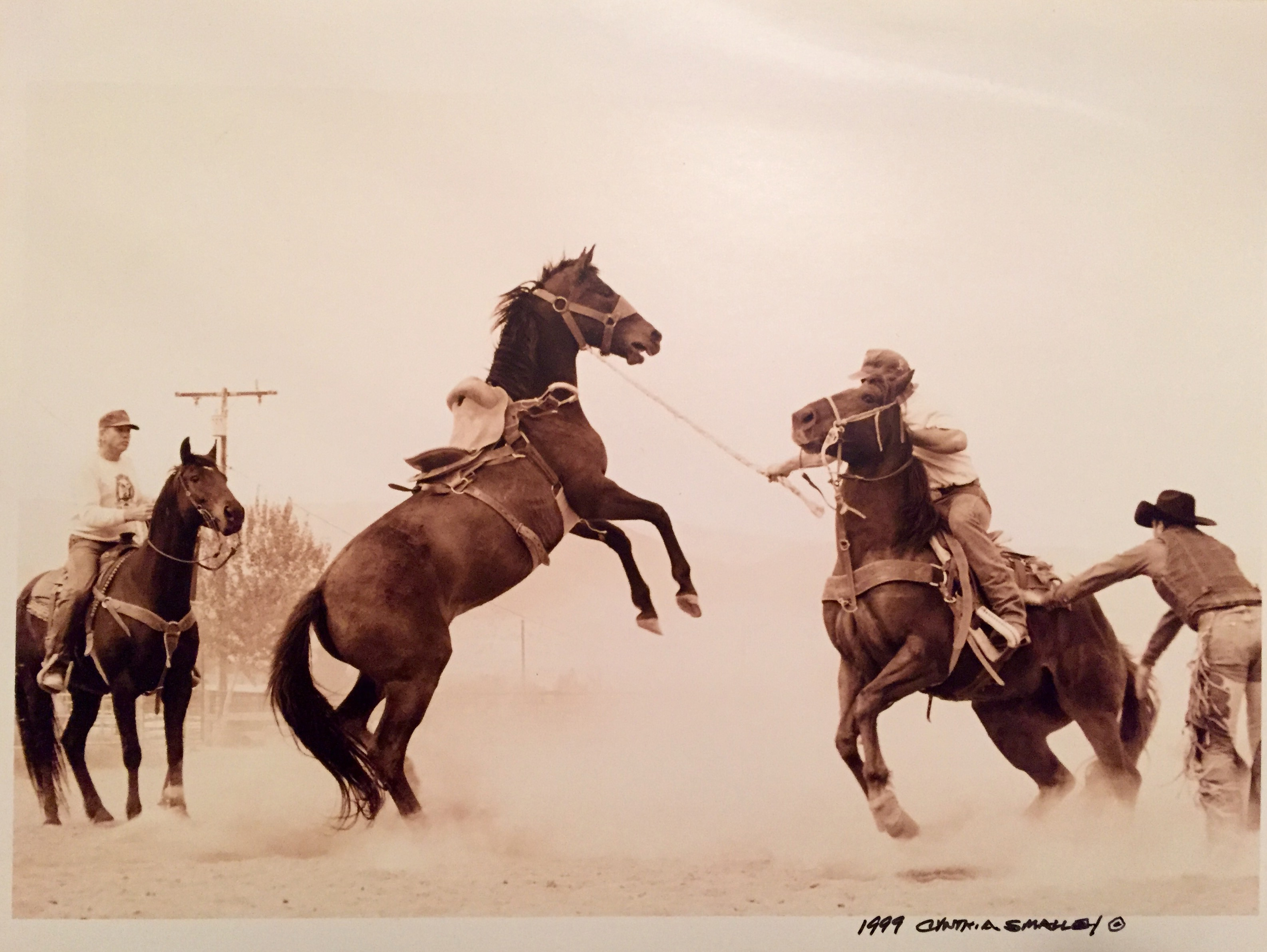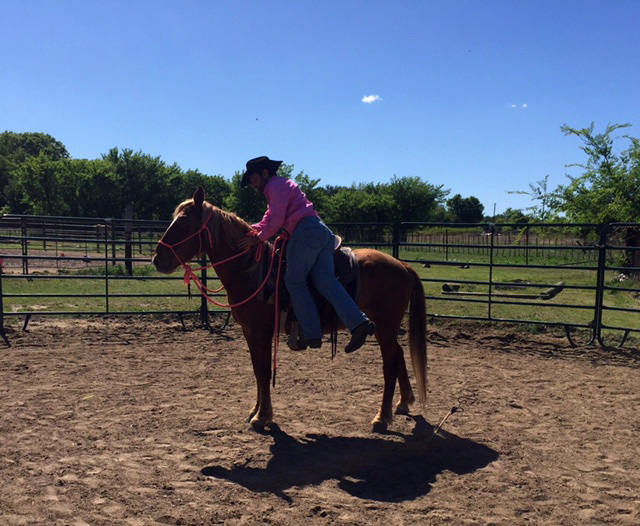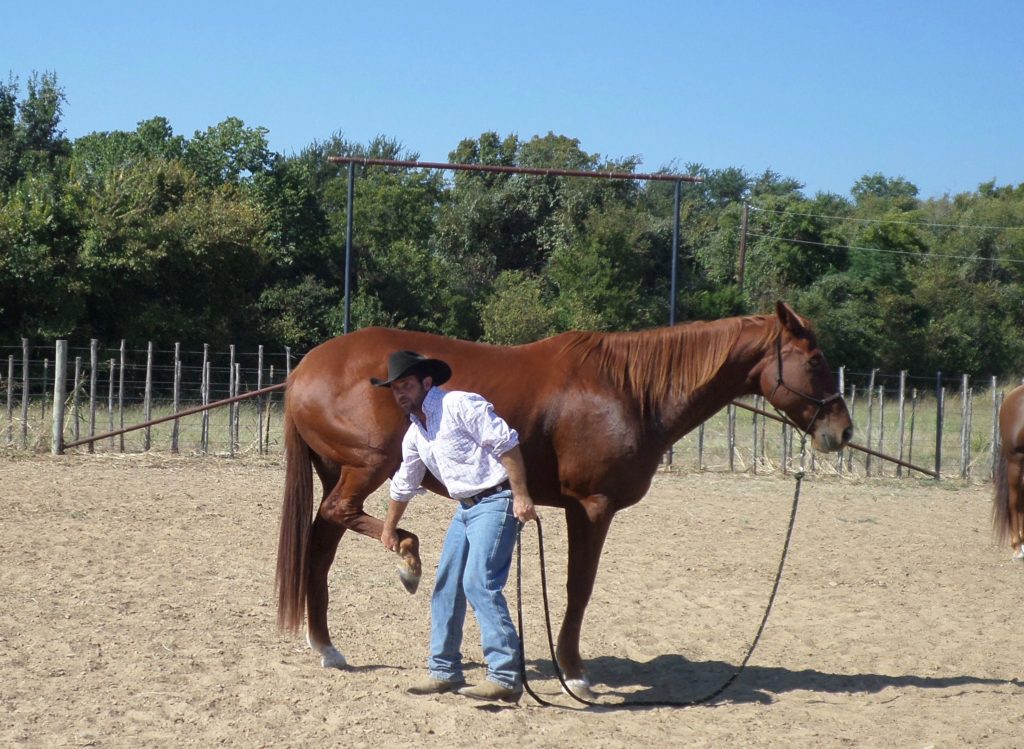The Natural Horseman
The Natural Horseman – First ride
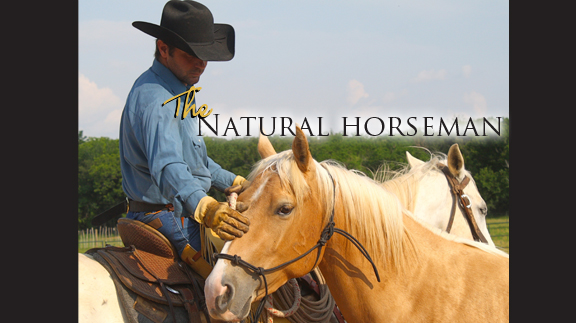
By Steve Stevens
I made my way from Albuquerque up Highway 550 north through the Jimez Indian Reservation, then through the Zia Reservation… on my way to a colt starting competition in Durango, Colorado.
The windows rolled down, I was enjoying the early morning breeze.
Watching the landscape change from desert to rocky hills, to open meadows and aspen trees. It is hard to not get lost in the vastness and think of the Native Americans that made this land their home so many years ago.
I think whether you’re going to a rodeo, a horse show, or a colt starting competition, it is so important to take in our western heritage. We wouldn’t be enjoying our life with horses and livestock if it wasn’t for the Native Americans and cowboys that rode before us.
As I continued driving, I was blessed to see a herd of wild horses running across an open plain.
I drove lost in the moment. There is a Navajo AM radio station you can pick up in this part of the country that has been running at least since I was a kid. They only play classic country, like Bob Wills or Mel Tillis. During the commercial breaks they speak in Navajo. At this time, the song “Coca Cola Cowboy” was playing. They talked about all the rodeos coming up. And today, September 11th, they said blessings for all of our fallen heroes lost on 9/11.
It was an emotional morning, thinking of old times and old friends from when I rodeoed in these parts back in my youth.
I started preparing in my mind for the colt starting that would be later that night and I started thinking about the first time I had gotten on a colt.
I had been spending time with a World Champion Steer Roper named Kenny Call, who seemed to like having dumb, naive kids around to torment. I say kid, but I was about 17.
At the time, I had no idea what and how much I had bitten off to chew.
I had been going up to Kenny’s place a lot. I was riding almost every day.
I had been riding just enough for me to think I knew everything there was to know about riding horses. Kenny always found ways to put you in a scenario that could humble even the most tenacious warrior. I had loosely been throwing around the fact that I was going to become a bronc rider.
One afternoon, I guess Kenny saw how boisterous I was and decided it was time for me to take one big step towards being a cowboy.
Kenny had grabbed a little paint colt, saddled it, chased it around to make sure it wasn’t too broncy. He got on his big horse named Dunny and ponied the little colt over to the middle of the arena. (Ponied means leading the horse from horseback.)
He trotted right up to me like he was John Wayne in the “The Cowboys”.
I’ll never forget his words to this day.
In his Okie twang and with a big twinkle in his eye, he said – “Alright cowboy, get on.”
I should have known better, but I was going to be a bronc rider… and there’s no time like the present.
Kenny dallied up snug on his saddle horn to the little paint so I could climb up safely.
His dun horse who was a superior athlete could be a little suspicious of things at times.
And I could see the whites of Dunny’s eyes as I climbed up between them.
Kind of a precarious position to be in, especially for me at the time.
I got my stirrups and Kenny said “Are you ready?”
Words I would later learn to take more seriously.
So, like Casey Tibbs, Larry Mahan, and so many other great rodeo cowboys before- I said “YEP”!
Kenny knew what was going to happen before it did.
Especially since I was just sitting straight up in the saddle, oblivious to what it feels like when a horse jumps forward and you are not holding onto anything, but your ego.
Kenny squeezed Dunny forward and pulled on the paints’ lead rope and halter.
Just like he thought-the little paint took a big jump forward and I flew through the sky like a box of rocks, only a box of rocks would have landed more gracefully than I did. I landed flat on my back, all the air being knocked out of me.
I tried to get up quick, but my body didn’t move.
Then as I refocused my eyes, I saw the nostrils of two horses.
And that little paint, Dunny and Kenny peeking over the top holding back the laughter.
As all tough cowboys would say to their would-be protege after they fall off of a horse-
Kenny said “Get back on!”
At this point I realized this wasn’t what I bargained for. It didn’t look like this when I watched Roy Rogers run Trigger a hundred miles an hour over jumps through rocky passes chasing the bad guys.
This hurt and wasn’t any fun at all.
I got up and tried to hold back the tears welling up in my eyes. I wasn’t going to let Kenny or the other onlookers see my fear so I climbed back on.
Kenny said “This time you might want to try a little harder”. Something at the time I knew little about.
I grabbed onto the saddle horn. Tucked down my chin and held on for dear life. Kenny led the little paint around and I am pretty sure he couldn’t have jumped over a penny. I held on for all I was worth as he scattered around. When I was done, (or I should say survived,) I was sure I was destined to be the next world champion bronc stomper.
I had no idea the long road ahead of me.
That day on that little paint would be one of the many moments in my life that would lead me to where I am today.
That day on that little paint would be one of the many moments in my life that would lead me to where I am today.
Every morning, I get up and start colts to put food on the table for my family.
It was nearly 25 years ago that Kenny put this kid on his first colt. How time flies.
This Friday and Saturday I will be competing at another colt staring competition for
Colt Starting Challenge USA.
This one is a bit closer to home, in Gainesville, TX.
If anyone wants to come out and watch a fun colt starting competition, here is the info:
P.S.
To this day, Kenny still torments me every chance he gets.
The Natural Horseman
This is why we do what we do — RayeAnn and Cisco
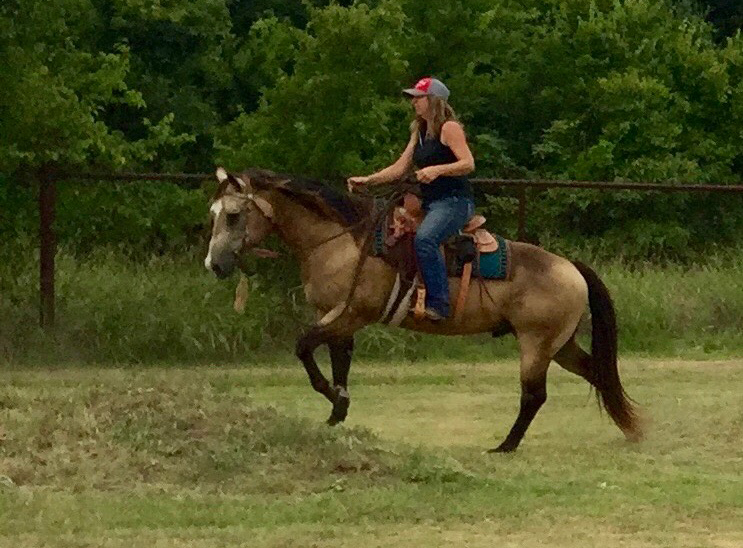
By Steve Stevens
RayeAnn brought her horse to us about a year ago and told us it was his last chance. Now we have heard this before from multiple other people about their horses. No pressure right?
But I knew RayeAnn was sincere about this and at the same time I could see her concerns about her horse, “Cisco.” She had put a lot of time and money into him already. He was stout and pretty, but you could see the white in his eyes and his distress just being turned loose in our round pen. He came with baggage, many different bad experiences, didn’t care much for being saddled, had random explosions and bolts. RayeAnn had been trying to ride him after the last trainer, but after a recent ride where, (if I remember correctly) while trying to change directions he spooked and bolted. RayeAnn is an excellent rider so she survived but she had had enough.
We listened to RayeAnn describe the past experiences she knew that Cisco had and asked lots of questions.
Then started at square one.
No matter if we get a colt, a horse that bucks, or a kid’s horse that doesn’t like to stand still, we start back at the beginning and try to put a solid foundation on them.
Cisco was tight and very nervous of everything during the ground work sessions.
I will go to my grave with this thought- if a horse is nervous or can’t deal with ground work they will not be easy to deal with riding. I slowly and consistently worked with Cisco doing basic lunging and desensitizing. He would make changes, but they weren’t big and it didn’t take much for him to revert.
I was and am always honest with the client when the horse is struggling and I told RayeAnn about his difficulties on the ground. Now, I know because we have done this so many times with other clients…when a client brings you a horse with riding issues they in general don’t want you to tell them about the issues you are having on the ground with the horse. But RayeAnn took it in stride and just told me to do what I needed to do.
I got to the point after a few weeks where I felt like Cisco was ready to start being saddled again. For a horse that had some rides under him, he was completely frightened about being saddled. This also transferred to him just carrying the saddle during ground work. It didn’t take much for him to blow up or grab his butt. I spent the next few weeks getting him as comfortable as I could with being saddled. I must have taken that saddle on and off a thousand times.
We had many sessions where I would saddle him and he would stand quiet, and I would just reward him by yanking the saddle off and putting him up for the day.
The biggest issue Cisco had was when he changed eyes. Meaning that things would go from him having vision of something in the left eye and when he saw the same thing out of the right eye it truly scared him. So we made it part of his training to always start with multiple changing eye directions. Once he started getting better with this, I started riding.
He was living in a stress zone at all times when you were on his back.
This became a delicate process. He wasn’t one of those horses you could lope the issue away by getting him tired. The harder you worked him the more panicked he would become, so I had to be subtle and easy. What I did was really search to reward him for any time he tried by relaxing, taking a deep breath, licking his lips. I would just shower him with affection when he would relax, once again sometimes just getting off of him, taking the saddle off and calling it a day.
Slowly but surely he started relaxing more and more and allowed me to ask more of him. It took nearly three months but I could finally saddle him easily and ride him off with little resistance. Cisco was a frightened horse that needed a lot of reassurance and confidence that he wasn’t going to be put in a situation he couldn’t deal with.
The second part of the story
RayeAnn had decided to have faith in me in my process even though it was taking more time and money then I am sure she would have preferred.
With many horses that come to us for training, we are trying to rehabilitate the horse and that certainly can be a process.
RayeAnn gave me that opportunity with Cisco.
But here is the amazing part of the story. I got Cisco where RayeAnn could go on with him, but if she just turned him out for months and pulled him out one day expecting him to be great, it would be a recipe for disaster. Especially with Cisco. But that is not what she did.
She dedicated herself to this horse. She has worked with him nearly every day since he left us, starting slowly with a game plan we gave her and building out. Cisco, even as far as we got him, wouldn’t be an easy deal. He would and could be frustrating, but RayeAnn’s sure will and determination would overcome to build a relationship with him.
A few weeks ago, we were doing a group obstacle lesson and RayeAnn and Cisco came out and joined us. Out of ten horses, Cisco was the most relaxed of the group. He looked liked a 20-year-old broke kid’s horse. I always like to say our job as trainers is to show the owner their horse’s potential and it is up to the owner to take the horse to the next level.
Well, RayeAnn did that with her boy Cisco and then some. I know she still has a ways to go, but RayeAnn is one of the true heroes of the horse industry, not giving up on a horse that with many others would have gone to the killers. She invested money, time and her heart.
I am truly inspired by her, and she is one of the reasons that I continue this dream of helping people with their horses.
Thank you RayeAnn.
HOME
The Natural Horseman – Miracle the Mustang

By Steve Stevens
So after a five year hiatus from Mustang competitions, we have decided to do another one.
We are planning on competing in Lexington, Kentucky, at the Extreme Mustang Makeover in early July.
I am currently on the 22nd session with our draw. We named this little draft cross with a flaxen mane “Miracle.” He gained his name due to the fact that we got the wrong mustang. He was not the one we drew for the competition. There was some sort of mix up that wasn’t figured out until he was half way home to Texas from Illinois. We also named him Miracle because of our long and hard but blessed journey we have traveled on since the last time we competed in a mustang competition.
The cool thing with working with untouched mustangs is that the trainer is fully responsible for how the mustang is, how he will become. Meaning that everything he does is because of me or his own mental and physical ability. I can’t blame the last owner or trainer.
There are no excuses.
It is a great honor and responsibility to be the first one to touch, handle and ride a wild mustang. They have very in- depth sensorial survival skills. They are also more toughened from their prior environment, so that human-horse connection can be a difficult barrier to break.
But if you can connect with them, the rewards can be extraordinary, and the bond can be tremendous.
To start, Miracle has been a little spooky, which is to be expected. But in the grand scheme of things he is really smart and has been trying hard. We spent the first three weeks just doing groundwork: teaching him to be caught, basic lunging, desensitizing, picking up feet, leading, saddling and driving. He has had six rides on him.
He seems to be learning something new every day. We will just have to wait and see how far he can go. Right now the main goal is getting him as trained as possible.
We are working on him just being able to walk, trot and canter in the bridle, and then we will go from there. I am always doing my best to put him first and not allowing the competition to rush the process.
I truly believe that working on becoming the best trainer I can be means that I have to keep educating myself, to never stop learning. Working with mustangs can certainly widen your education and keep you humble.
We will keep updating you guys on my journey with Miracle.
HOME
The Natural Horseman – Horses that have trouble being trimmed

By Steve Stevens
So often we get horses in training or have someone ask us what to do about their horses that throw fits with their farrier. The horses won’t stand still, pull back, won’t pick up their feet or even can strike and kick. Their farrier is always upset, doesn’t want to work on their horse or even worse, because the horse is giving them a rough time, the farrier takes his frustration out on the horse.
There are a few factors here that need to be dealt with.
The first is for the owner to understand that for a lot of horses, having their feet worked on can be very stressful and overwhelming. Most farriers don’t have the time and/or patience to go slow and help train your horse. The only way they can make a living is to hurry up and move on as soon as possible to get to the next horse. So it now becomes OUR responsibility to prepare our horse. If your horse won’t stand still for you to pick up all four feet, and clean their hooves out with a hoof pick, they probably aren’t ready for the farrier who will be in a rush, will have multiple clanging tools and will be asking your horse to get into fixed positions.
We must be consistent with picking up our horse’s feet and letting them get comfortable with that. If your horse is giving you a rough time or you are scared to pick up their feet, you must find a professional to help.
With all the problem horses I have worked with, one of the most important philosophies we have learned and practiced is a very simple concept:
IF YOUR HORSE WON’T STAND STILL FOR YOU TO PICK UP HIS FEET, GROOM HIM OR SADDLE HIM NOT BEING TIED, THEN HE IS NOT READY TO BE TIED UP.
See, when a horse is tied hard, we take away their ability to move their feet.
So if they get scared, they are trapped and most often will fight, pull back, fall down, kick and get worse at the task at hand. How many times have you tied up your horse hard and he got scared and fought it, got through it for the time being, but then when you come back another day he has the same issues?
We need to understand how horses process their thoughts. A horse feels safer when he has the ability to move his feet. It’s easier for him to work through things. Once we take that ability away, he will most always fight if he gets scared or bothered. So before we ever tie him up, we must learn how to do these tasks with him untied.
I know this goes against all the old school techniques. But trust me…we get the horses in training after the old school techniques don’t work…after horses have pulled back, broke multiple halters, split their heads open, nearly killed the farrier and/or yourself.
The second factor is that owners need to have the courage to stand up to their farrier if they see things are getting out of control. If a horse is getting more scared, and the farrier is getting more upset, it is ok to say, “That can be enough for today, let me work with him a little bit more before he or she gets anyone hurt.” So what if your horse’s feet get a little long and you have to pay a bill? It is better than the alternative of being scared to death every time he gets trimmed.
If you have a farrier worth his salt, he will be appreciative that you don’t want him to get killed today trimming your horse. If he tells you otherwise, it’s probably time to find another farrier. I can’t tell you how many times clients have brought me horses that have foot issues, can’t be tied or go running to the other side of the pen when the farrier comes. The client often tells me something like, “I knew it was getting worse every time my horse got trimmed, but I just felt bad to stop using my farrier. He is a really nice guy.” We must find the strength to do what is right for the horse and if you have to go through five farriers to do so, that is fine.
I probably sound like I am bashing farriers right now, but actually I have more respect for a farrier’s profession than anyone. It is not easy to have to get under crazy horses all day long in the elements. I have been blessed to know a handful of amazing farriers who are always on time, patient, knowledgeable and understanding. They know that if they are going to work on your horse for the next twenty years, that if they take their time the first couple of times, it should be easy for the next two decades.
The third factor is to do the training with a horse that is having a hard time. If a horse nips, or kicks, leans or won’t stand still, we must try our best to correct the issue.
The easiest way to do this is to move their feet, to make them work, hustle them by lunging, doing rollbacks, driving their hindquarters around.
I will give you an example. If I were holding a horse for the farrier and she kicked or tried to bite him, I immediately would start lunging that horse, making it work. That is how we can make the wrong thing difficult. So make sure your horse can lunge well, change directions and back up well on a lunge line.
THE NEXT TIME YOUR HORSE GIVES YOU OR THE FARRIER A TOUGH TIME, PUT IT TO WORK.
The more aggressive the behavior, the longer I will hustle them. The toughest part about this exercise is having the wind to really put some effort behind this and hang in there long enough that they get the point. Once you are done, bring them back to where you started and go back to work like nothing ever happened. This may take two to three times to really take effect, depending on your ability and expertise.
Just remember, if things are going bad when getting your horse’s feet done, it will only get worse if you don’t work on fixing the problem.
Have faith that there are amazing farriers out there and take the time to find them.
-

 Country Lifestyles2 years ago
Country Lifestyles2 years agoScott & Stacey Schumacher: A Growth Mindset
-

 Country Lifestyles8 years ago
Country Lifestyles8 years agoStyle Your Profile – What your style cowboy hat says about you and new trends in 2017
-

 HOME8 years ago
HOME8 years agoGrazing North Texas – Wilman Lovegrass
-

 Outdoor10 years ago
Outdoor10 years agoButtercup or Primrose?
-

 Country Lifestyles5 years ago
Country Lifestyles5 years agoAmber Crawford, Breakaway Roper
-

 Country Lifestyles9 years ago
Country Lifestyles9 years agoJune 2016 Profile – The man behind the mic: Bob Tallman
-

 Equine1 year ago
Equine1 year agoThe Will to Win
-

 Country Lifestyles8 years ago
Country Lifestyles8 years agoDecember 2016 Profile, Rusty Riddle – The Riddle Way

